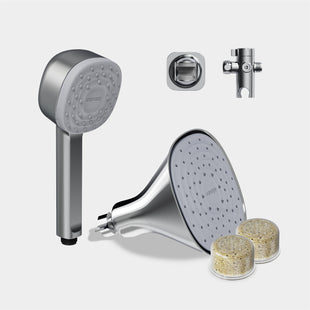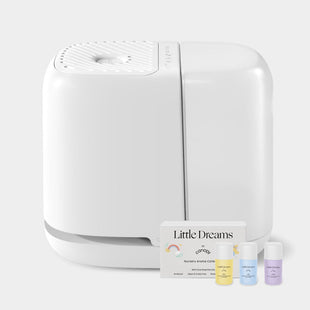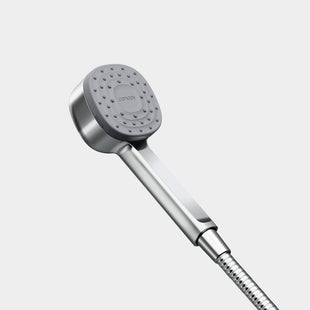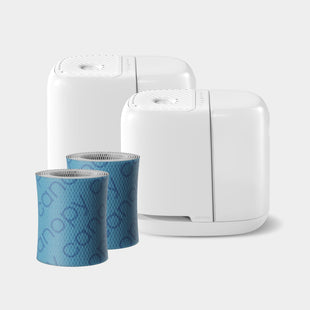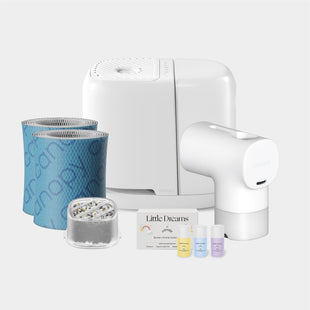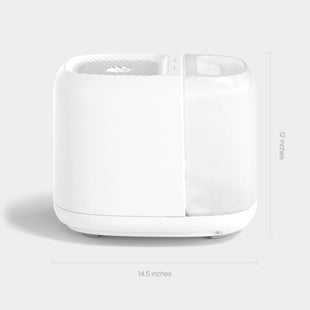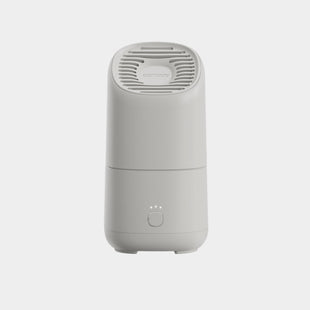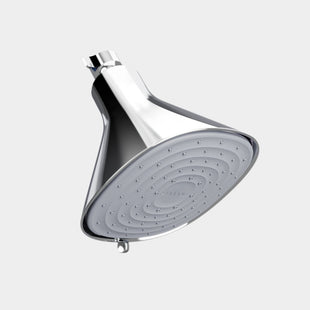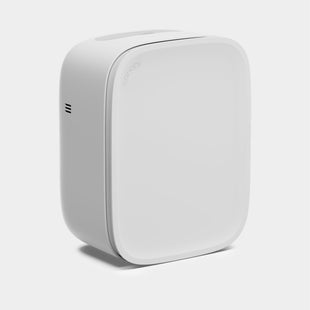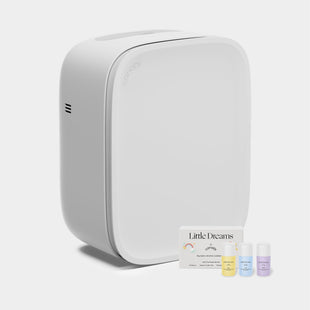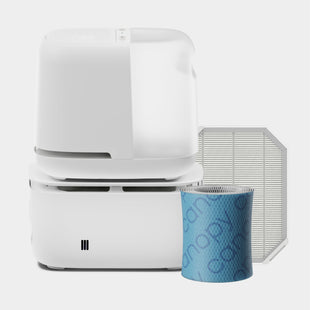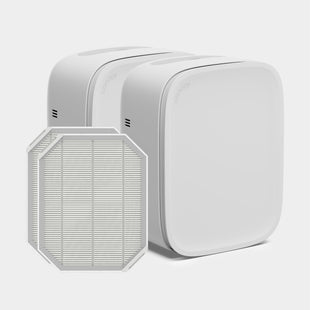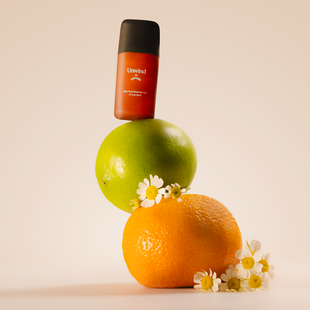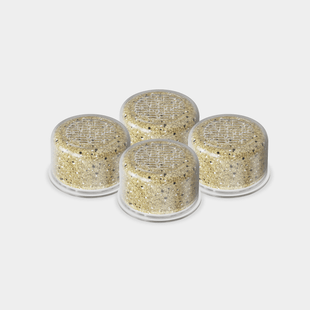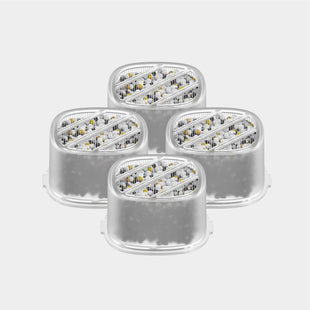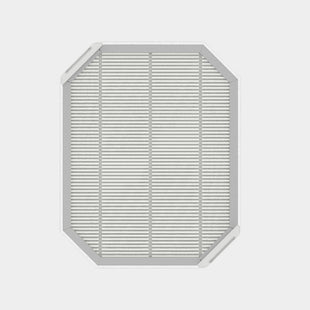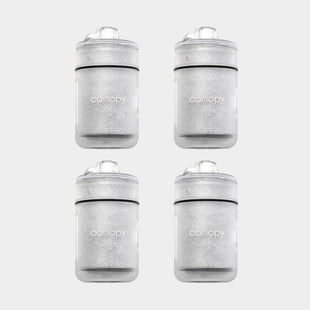This content has been reviewed and updated on May 23, 2024.
Got allergies? You’re in good company: As many as 50 million Americans experience the aggravating symptoms of hay fever. The good news is there are all sorts of remedies, including simple fixes you can make right in your own home.
For instance, did you know that using a humidifier or vaporizer for allergies can dramatically improve symptoms? But before we dive into the benefits of adding moisture to your home to combat allergies, let’s explore these devices so you can decide which is right for you.
What Does a Vaporizer Do?
Technically, a vaporizer can be categorized as a type of humidifier. In general, a humidifier is any device that adds moisture to the air to increase its relative humidity (RH). But there’s an important distinction: humidifiers can either produce cool mist or warm mist. Warm mist humidifiers are also known as vaporizers.
A vaporizer works by boiling water from the water tank to create vapor or steam, which is subsequently fanned into the room. While a vaporizer can slightly elevate the temperature of a room, the steam released from the vaporizer cools before reaching surrounding surfaces.
A cool mist humidifier, on the other hand, releases cool mist into the surrounding space through evaporation or ultrasonic technology. The American Academy of Pediatrics advises against the use of vaporizers around babies, small children, or rambunctious pets. While the vapor itself is not hot when it settles in the room, the device can get knocked over, causing the boiling water to spill and creating serious safety hazards.
Benefits of Humidifiers
While increasing the moisture level in your home sounds great, what are the tangible benefits of humidifiers? These devices allow you to achieve the right levels of home humidity: between 40% and 60% are considered “optimal” for maximum health benefits and comfortable living conditions.
Regular humidifier use in your home or living space contributes countless benefits to your health, the health of your family, and even certain aspects of your household. For instance, regularly using a humidifier can:
- Improve the signs of skin aging, including fine lines and wrinkles
- Rehydrate dehydrated skin that is often red, itchy, flaky, or painful
- Reduce dandruff and improve scalp hydration
- Improve the overall appearance and health of hair
- Reduce or eliminate common cold and flu symptoms, including congestion, runny nose, scratchy throat, and more
- Reduce the survival rate of airborne pathogens and improve the quality of home air
- Improve snoring and reduce morning congestion for better quality sleep
- Improve nasal congestion in babies and small children
- Improve dry skin conditions in babies, including eczema and psoriasis
- Prolong the lifespan of houseplants and improve their overall appearance
- Improve the health of wood foundation and wood furniture in the home
While humidifiers offer an array of whole-body benefits, they’re also key players during allergy season. These small yet mighty devices can help you navigate an otherwise uncomfortable spring and summer.
Does a Humidifier Help With Allergies?
If you’re seeking an easy lifestyle change that can help your allergy symptoms, running any type of humidifier is one of the best options to consider. Using a humidifier for allergies can lead to a noticeable improvement in symptoms, including dry throat, cough, nasal congestion, and runny nose, among others.
While outdoor allergens can be a common trigger for symptoms, your indoor air quality can have a major impact on your symptom severity, too. Consider that you likely spend most of your time indoors. It’s therefore important to have clean, breathable air that’s well-hydrated. If your air is too dry—below the 40% to 60% humidity threshold—you may find yourself experiencing worsened symptoms.
Dry air will pull moisture from your airways, leading to inflammation and irritation. Sufficiently hydrated air (achieved with a humidifier) will lubricate your nasal passages and throat, on the other hand. This in turn will reduce inflammation and support easier breathing—a big win for alleviating allergy symptoms. And if you experience dry or irritated eyes, dry skin, or a scratchy throat, introducing a cool-mist humidifier into your space can dramatically improve these and other allergy symptoms.
There are some considerations to bear in mind, however. When using a humidifier for allergies, regular maintenance is particularly important. At Canopy, we make cleaning your humidifier simple: Remove the tank, cap, and tray and place them in the dishwasher. For safety, avoid putting the body of the humidifier in the dishwasher, as this component holds the fan and electrical unit.
Cleaning your device weekly and avoiding using stagnant water in the water tank will prevent bacteria and contaminants from infiltrating your home air and triggering further allergy symptoms.
Additionally, monitoring humidity levels with a hygrometer is a great way to avoid excessive humidity in your home, which can also trigger allergy and asthma symptoms. When home humidity levels exceed 60%, the excess moisture provides a cozy breeding ground for mold, bacteria, and other allergens.
Using Canopy for Simplified Allergy Relief
For an alternative to a vaporizer for allergies that doesn’t rely on boiling water to produce hydration, consider Canopy’s Portable Humidifier. Perfect for small spaces, like your office or a hotel room, this travel-ready device produces a cool, fine mist to achieve balanced moisture wherever you go. Leave your allergy symptoms behind and keep your space well-hydrated with this soothing system.
Hydrate the whole bedroom with our Bedside Humidifier, which covers up to 500 square feet of space. It’s equipped with sensors that help maintain optimal moisture levels night and day. For larger spaces, consider our Large Room Humidifier, which covers up to 1,000 square feet of space. This device has a run time of 18 to 36 hours with a full tank of water, providing a comfortable level of moisture when you need it. If you have a baby or toddler, consider installing a Nursery Humidifier in their room. This device promotes easy breathing and better sleep, as it hosts Smart Persistent Airflow Technology, which deters mold growth in the unit.
Keep in mind that unlike the Portable Humidifier, these devices don’t release any mist or vapor. Instead, they add moisture to the air via a unique evaporative system. Water passes through a UV light to inhibit mold* inside the humidifier and bacteria, and a sensor works to maintain optimal moisture day and night.
No matter what your allergy symptoms entail, adding a humidifier to your care plan can help manage them effectively. Whether it’s seasonal pollen or pet dander that’s giving you trouble, having hydrated air everywhere you go will support easier breathing and better comfort.
*Mold inhibition limited to device interior. Does not treat air or environment. 3rd party lab-tested with Aspergillus niger (ATCC 6275, 16404).

